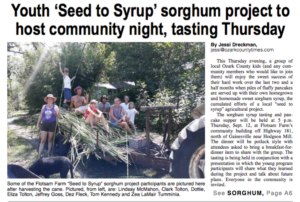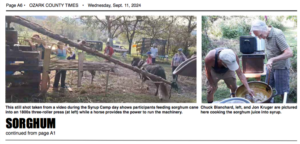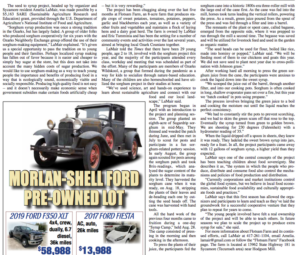Final report for YENC24-219
Project Information
A multi-generational group of farmers, young people, and their families will collaborate to plant, tend, harvest, and process sweet sorghum into syrup. This project will teach kids cooperative work, food sovereignty, organic agriculture. Monthly workdays will be held throughout the season, culminating in a two day "Syrup Camp" where participants harvest, cook, and bottle syrup. In additional to hands-on learning. each workday will include a sustainable agriculture lesson. We hope to produce enough syrup to supply each family involved, and establish a successful youth-led cooperative venture that continues a long-time Ozarks tradition.
1. Teach young people how to grow and process sorghum using environmentally sustainable methods including integrated pest management, soil testing, composting, organic gardening practices, and appropriate technology.
2. Strengthen community bonds and food sovereignty by passing the tradition of local, cooperative syrup-making to the next generation.
3. Produce syrup for at least 10 local households, providing an economically feasible alternative to highly refined sugars produced far away and with a long and ongoing history of questionable labor and environmental practices.
4. Document and share the project through local media, social media, and 2 public presentations.
Educational & Outreach Activities
Participation Summary:
Three news articles were published about this project. These included an article in our weekly county newspaper, The Ozark County Times, as well as a center spread in the The West Plains Daily Quill's weekend edition.
Desiree worked with the kids to write and illustrate an article about the project for a local newsletter/ zine The Ozarks Agrarian News, which has 145 subscribers.
Two handouts were created for the classes:
- One giving a basic overview of the project timeline and sustainable agriculture: Sorghum Handouts YENC24-219
- One outlining the process we followed for pressing and cooking the sorghum: Sorghum Pressing - YENC24-219
Throughout the season, project updates were shared with Flotsam Farm's mailing list, as well as on Instagram and Facebook.
The two pressing and cooking days (Aug 28 and 29) were open to the public (counted as "on farm demonstrations") , and were advertised through local media as well as online. Several folks who were not otherwise involved in the project came out to observe and lend a hand.
A pancake and sorghum dinner, slideshow, and project re-cap event was held at Flotsam Farm on September 12.
Amelia gave a presentation about the project to about 40 people at the annual Ozark Area Community Congress in October. One of the youth participants also shared a series of poems that she wrote about the project at that event.
Amelia also talked about the project in a radio interview on Columbia MO's public radio station KOPN on January 22. The interview is available here: https://www.kopn.org/programs/farm-and-fiddle/
Finally, the group created a "sorghum pirate" themed float for Gainesville's annual Hootin an Hollarin parade, and won grand prize!
Learning Outcomes
How to grow and process sorghum into syrup
The three pillars of sustainable agriculture
Food sovereignty
Sustainable agriculture practices (cover cropping, IPM, pollinator habitat, organic inputs, etc.)
Twelve of the youth participants completed the post-project survey. Due to the wide age range of participants (2-18) I made the survey fairly simple. They were asked "How much did you know about growing and making sorghum syrup before participating in this project?" 9 responded "nothing at all", and 3 said "a little". All twelve affirmed that they understood how to grow and make sorghum syrup after participating in this project, and 9 out of 12 said they would like to be involved in growing sorghum again.
When asked "What was the most interesting part of the Seed to Syrup project?" 2 chose "working cooperatively", 4 chose "learning sustainable practices", 3 chose "planting and tending the sorghum crop", 2 chose "Collecting data (Brix reading, pest scouting, etc.)", 5 chose "harvest day", 7 chose "pressing and cooking", and once chose "other", but didn't elaborate. I'm glad that many different aspects of the project were appreciated.
All 12 youth correctly chose "The people who produce, distribute, and consume food control the mechanisms and policies of food production and distribution." as the definition of food sovereignty. The majority of participants were also able to correctly select which practices exemplified each of the 3 pillars of sustainable agriculture.
75% of those surveyed, along with several others anecdotally, indicated that they would like to be involved in growing sorghum cooperatively again. To me, this is the biggest indicator that this project was a great success!
I did not use any specific curricula, but we did refer to several university publications (links below) for information about growing and processing sorghum, as well as information on sustainable agriculture from SARE (What is sustainable agriculture?). We also relied on knowledge shared by several local old timers, as well as others who had been involved in sorghum production more recently. YouTube videos were helpful for learning the setup and general process.
Sorghum Resources:
http://corn.agronomy.wisc.edu/Crops/SorghumSyrup.aspx
https://extension.psu.edu/sweet-sorghum-production-basics
https://digital.library.unt.edu/ark:/67531/metadc6267/
https://nssppa.org/sorghum-production
Videos:
https://youtu.be/8fYBjrlY1k4?feature=shared
https://youtu.be/e3kXKMTcahI?feature=shared
https://youtu.be/poWPZdJas0Q?feature=shared
None of the resources I used were specifically geared toward educating youth, but otherwise I think they provided reliable research-based information. This was a very hands-on learning project, and monthly activities were determined by what needed to be done in the growing season, so there wasn't much need for a curriculum.
Project Outcomes
Thank you very much for the opportunity!
I think reminding project coordinators to look at these reporting questions as they are starting their projects would yield more useful information. It has been difficult to get some of the families who participated to respond to follow up questions now that the project is over.


